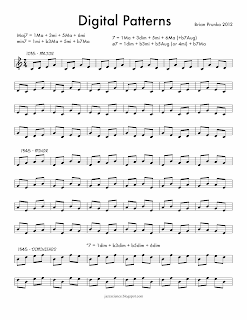Okay, I haven't posted in a year. Here's a little worksheet of common patterns that are often used by modern improvisers. John Coltrane was probably the first to make notable use of these kinds of patterns, which he did on the record "Giant Steps".
I took the basic patterns and explored the possibilities for reordering the notes and for octave displacement.
There are 24 different ways to order four notes, these are all listed for each type.
If you add in octave displacement of various notes, you end up a lot more variations. I just did the first example from each chord type . . . you can work out the rest.
You can use these starting on different chord degrees, the first page lists some possibilities:
• Use the major pattern from the root or 5th of a maj7 chord, or from the 3rd or 7th of a min7 chord
• Use the minor pattern from the 3rd or 6th of a maj7 chord, or from the root or 5th of a min7 chord
There are other possibilities for half-diminished, diminished, or dominant chords:
Dominant: Major from root or 6th, dim. from 3rd, minor from 5th
Diminished: Dim. from root, b3, b5, or 6 (bb7)
Half-diminished (min7b5): Dim. from root, minor from b3 or 4, aug. from b5, major from 7.
By altering these, you can get a bunch of patterns that are useful over dominant and diminished.
You can also substitute and extend these, for example:
• Playing the patterns for Db7 will give you altered sounds when applied to G7
• Playing the patterns for Em7 will give you Lydian sounds when applied to Cmaj7
• The patterns for min7b5 work for a min6 chord a m3rd up (use Amin7b5 for Cmin6)
Which brings up another idea, these patterns are all a triad with one added note, a useful concept. Could be another post to come . . .
PDF here



No comments:
Post a Comment